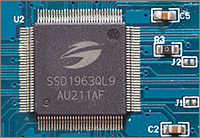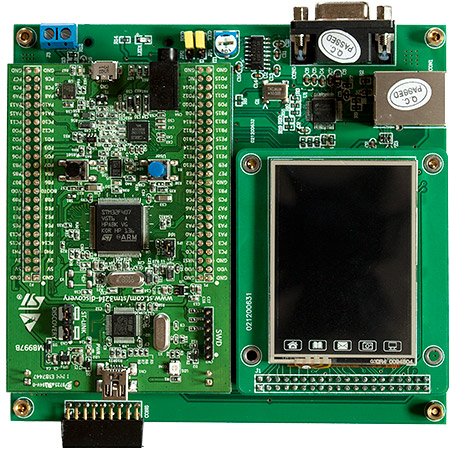stm32plus 2.1.0

|
The latest release is now 3.0.0. Be sure to check out the announcement here.
Due to the use of c++0x features the minimum compiler requirement is now version 4.7.0 of gcc |
stm32plus version 2.1.0 has now been released and is available from my downloads page. This article will present a brief overview of the following new features.
- LGDP453x TFT driver
- SSD1289 TFT driver
- SSD1963 TFT driver
- ST7783 TFT driver
- AT24C32/64 serial EEPROM support
As mentioned in the banner at the top of this page you will need to ensure that you are using at least version 4.7.0 of gcc. I’m currently working on a driver for one of the big on-chip peripherals and it just couldn’t be done cleanly without real variadic templates so I took the opportunity to migrate all the template ‘feature’ mix-in classes to variadics. I also replaced lots of subclass types that were there as a workaround for the lack of template typedefs with much cleaner template aliases.
I use the free ‘arm-2012.09’ arm-none-eabi gcc release supplied by CodeSourcery (aka. Mentor Graphics) on Windows 7 x64 and Ubuntu Linux and I recommend that you do too. Other gcc toolchains may also work but are not tested. non-gcc compilers will certainly not work.
The installation and usage instructions have not changed since version 2.0.0. Documentation can be found in this previous article.
LGDP453x TFT driver
The LGDP4531/2 is a 320×240 (QVGA) TFT panel from LG. The stm32plus driver for this panel was contributed by Andy Franz and gratefully accepted by myself into this release.
64K and 262K colour modes are supported in landscape and portrait orientations. A full list of driver declarations are:
LGDP453x_Portrait_64K LGDP453x_Landscape_64K LGDP453x_Portrait_262K LGDP453x_Landscape_262K
Andy created a corresponding example demo that you can find in the ‘examples/lgdp453x’ directory.
SSD1289 TFT driver
Experimental support is now provided for the Solomon Systech 1289 QVGA TFT driver with 64K and 262K colours and in landscape and portrait mode. The driver names are:
SSD1289_Portrait_64K SSD1289_Landscape_64K SSD1289_Portrait_262K SSD1289_Landscape_262K
An example demo program is supplied in the ‘examples/ssd1289’ directory.
I have labelled this driver as experimental because I have not been able to verify that it works with the cheap ebay SSD1289 panel that I have because my cheap panel appears to be hardwired into an interlaced mode.
That is, if you set a display window to cover the whole screen and then fill it with pixels then the pixels will fill the rows in this order: 1,0,3,2,5,4… This makes it impossible to support with my graphics driver.
The offending driver input line is ‘GD’ and of course it’s the only one you can’t set in software using the ‘driver output control (r01h)’ register. Hopefully one of you will have a panel with ‘GD’ set to the non-interlaced mode!
SSD1963 TFT driver
 The SSD1963 is another one from Solomon Systech. It’s slightly unusual in that it’s not hard-wired to any particular resolution. Instead it allows you to program it to support any resolution up to 800×480 as long as you know the timings for the panel that you’re going to use.
The SSD1963 is another one from Solomon Systech. It’s slightly unusual in that it’s not hard-wired to any particular resolution. Instead it allows you to program it to support any resolution up to 800×480 as long as you know the timings for the panel that you’re going to use.
The stm32plus driver for the SSD1963 calls upon small ‘traits’ classes to supply the timing and size information for the panel being controlled. My test panel is a 4.3″ 480×272 device obtained on ebay and I have supplied traits classes for it. The driver names are:
SSD1963_480x272_Portrait_262K SSD1963_480x272_Landscape_262K SSD1963_480x272_Portrait_16M SSD1963_480x272_Landscape_16M
I’ve put together a short video of this panel in action connected to the STM32F103.
ST7783 TFT driver
I’ve got a cool new docking expansion board for my STM32F4DISCOVERY that adds some common peripherals to the system including an ethernet PHY, an RS232 socket, an SD cage and of course a QVGA LCD with a touch panel.

The driver IC for this panel is the ST7783 and I am pleased to announce support for it with 64K and 262K colours in portrait and landscape modes. The driver names are:
ST7783_Portrait_64K ST7783_Landscape_64K ST7783_Portrait_262K ST7783_Landscape_262K
I also put together a short video that shows it in action. The F4 drives this panel very quickly indeed.
AT24C32/64 serial EEPROM support
 Unlike some other devices such as the 8-bit AVRs the STM32 doesn’t have any EEPROM memory included on-chip although it is possible to emulate it to some extent by reading and writing the internal flash memory at runtime.
Unlike some other devices such as the 8-bit AVRs the STM32 doesn’t have any EEPROM memory included on-chip although it is possible to emulate it to some extent by reading and writing the internal flash memory at runtime.
If you need real EEPROM support then you have to purchase and wire up an external IC.
The Atmel AT24C32 and AT24C64 are 32/64Kbit serial EEPROM devices that are controllable via an I2C bus. The STM32 I2C on-chip peripheral is ideally suited to communicating with these memories.
stm32plus provides two drivers named ‘AT24C32’ and ‘AT24C64’ to manage communication with these devices. Both drivers inherit from InputStream and OutputStream so you can use all the methods that the stream interfaces provide.
The driver class is templated with the I2C interface that you are going to use to communicate with it. An example declaration might be:
#include "config/stm32plus.h" #include "config/i2c.h" #include "config/eeprom.h" typedef AT24C32< I2C2_Default<I2CTwoByteMasterPollingFeature> > MyEeprom; I2C::Parameters params; MyEeprom eeprom(params);
A full example is included in the ‘examples/i2c_at24c32’ directory.
Changelog
Here’s the changelog for version 2.1.0 in full.
Accepted LGDP453x TFT driver and demo contributed by Andy Franz. Thanks Andy!
Added drivers for SSD1289, SSD1963 and ST7783 LCD interfaces. Demos are included.
Change compile flags to C++0x with GNU extensions. This will facilitate a migration to variadic templates for the feature classes. The motivation for the migration is cleaner and smaller code generation.
Ported all peripheral classes that allowed template features to variadic templates.
Ported all LCD interface declarations from subclasses to template typedef aliases. Removed the colour depth suffix from graphic terminal class names, i.e. remove _64K, _262K suffixes. This is because there’s no difference between the colour depths making the suffix irrelevant.
Replaced SmartArray.h with scoped_array.h and scoped_ptr.h lifted from the open source Chromium project with appropriate credits.
Added reset() method to MillisecondTimer to bring the clock back down to zero.
Fixed STL slist for modern, stricter compilers.
Increased reliability of ADS7843 touch screen by preventing the pen interrupt from occurring while sampling is taking place.
Replaced the 3 GraphicTerminal* classes with a single GraphicTerminal template. The terminal declarations for each LCD interface have been updated accordingly. Graphics terminal declarations have now lost the colour depth suffix. So for example:
ILI9325_Terminal_Portrait_262K<LcdAccess>
would now be:
ILI9325_Terminal_Portrait<LcdAccess>
Also, the terminal class constructor is now a reference and not a pointer.
Implemented AT24C32/64 serial EEPROM classes with I2C interface. An example program is provided. Include “config/eeprom.h” to get access to the class.
Created StreamBase base class for InputStream and OutputStream and lifted up the error codes into the base as well as the common close() interface method.
Update: bug notification
A bug has come to light that affects optimised builds. It’s too small for me to do a full release so I’ll explain here what you need to do to fix it.
The problem is that the counter used by the MillisecondTimer class should be declared volatile. You can fix it like this:
In stm32plus/include/timing/MillisecondTimer.h change the counter declaration to include ‘volatile’:
public: volatile static uint32_t _counter;
Also change it in the source file: stm32plus/src/timing/MillisecondTimer.cpp:
volatile uint32_t MillisecondTimer::_counter;






